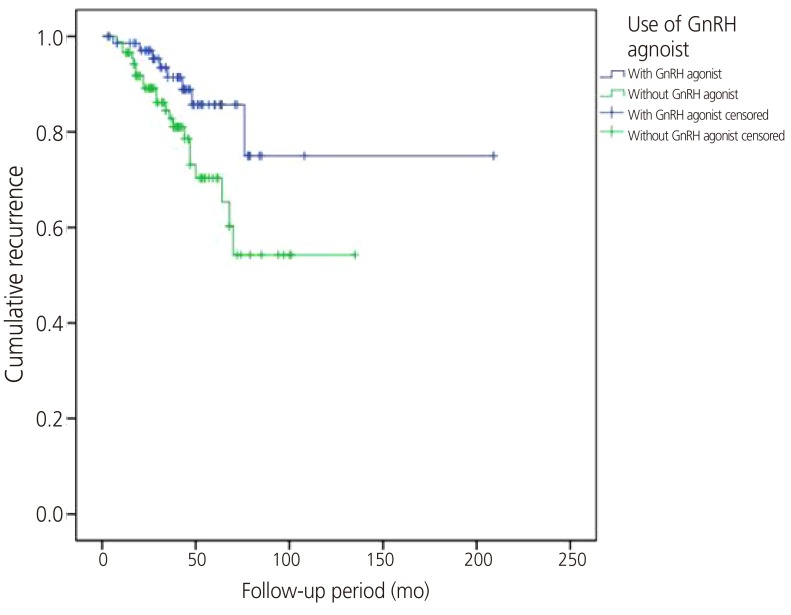Obstet Gynecol Sci.
2017 Mar;60(2):193-199. 10.5468/ogs.2017.60.2.193.
Recurrence factors and reproductive outcomes of laparoscopic myomectomy and minilaparotomic myomectomy for uterine leiomyomas
- Affiliations
-
- 1Department of Obstetrics and Gynecology, Chungnam National University Hospital, Chungnam National University School of Medicine, Daejeon, Korea. oldfox@cnuh.co.kr
- 2Department of Preventive Medicine and Public Health, Chungnam National University School of Medicine and Research Institute for Medical Sciences, Daejeon, Korea.
- KMID: 2372804
- DOI: http://doi.org/10.5468/ogs.2017.60.2.193
Abstract
OBJECTIVE
The aim of this study was to determine recurrence factors and reproductive outcomes of laparoscopic myomectomy (LM) and minilaparotomic myomectomy (MM) for treating uterine leiomyomas.
METHODS
Between 2007 and 2013, 160 patients underwent myomectomy, including 122 who underwent LM and 38 who underwent MM. Patients were followed up for recurrence based on pelvic ultrasound exams. Only patients who were followed up for a minimum of two years were selected for this retrospective study. Pregnancy rate, delivery, and delivery methods were compared between the two groups to evaluate reproductive outcomes. Furthermore, mean age, body mass index, preoperative administration of gonadotropin-releasing hormone agonist (GnRHa), and characteristics of leiomyomas were investigated to determine recurrence factors.
RESULTS
The mean body mass index in the MM group was significantly (P=0.048) higher than that in the LM group. The number and the largest diameter of removed leiomyoma were also significantly higher in the MM group (both P=0.001). Logistic regression after adjusting significantly different characteristics showed that the LM group had shorter (P=0.020) postoperative hospitalization days compared to the MM group. Other outcome variables including recurrence rate were not significantly different between the two groups. Reproductive outcomes such as pregnancy rate, delivery, and delivery methods were not significantly different between the two groups. Preoperative GnRHa therapy was the only significant (P=0.039) recurrence factor after myomectomy.
CONCLUSION
This study showed that LM and MM had similar recurrence rates and reproductive outcomes. The only recurrence factor of significance was preoperative administration of GnRHa.
Keyword
MeSH Terms
Figure
Reference
-
1. Marshall LM, Spiegelman D, Barbieri RL, Goldman MB, Manson JE, Colditz GA, et al. Variation in the incidence of uterine leiomyoma among premenopausal women by age and race. Obstet Gynecol. 1997; 90:967–973. PMID: 9397113.
Article2. Jin C, Hu Y, Chen XC, Zheng FY, Lin F, Zhou K, et al. Laparoscopic versus open myomectomy: a meta-analysis of randomized controlled trials. Eur J Obstet Gynecol Reprod Biol. 2009; 145:14–21. PMID: 19398260.3. Kaminski P, Gajewska M, Wielgos M, Sodowski K, Szymusik I, Bartkowiak R, et al. Laparoscopic treatment of uterine myomas in women of reproductive age. Neuro Endocrinol Lett. 2008; 29:163–167. PMID: 18283255.4. Benedetti-Panici P, Maneschi F, Cutillo G, Scambia G, Congiu M, Mancuso S. Surgery by minilaparotomy in benign gynecologic disease. Obstet Gynecol. 1996; 87:456–459. PMID: 8598975.5. Fagotti A, Ferrandina G, Longo R, Mancuso S, Scambia G. Minilaparotomy in early stage endometrial cancer: an alternative to standard and laparoscopic treatment. Gynecol Oncol. 2002; 86:177–183. PMID: 12144825.
Article6. Fanfani F, Fagotti A, Ercoli A, Bifulco G, Longo R, Mancuso S, et al. A prospective randomized study of laparoscopy and minilaparotomy in the management of benign adnexal masses. Hum Reprod. 2004; 19:2367–2371. PMID: 15242993.
Article7. Fanfani F, Fagotti A, Longo R, Marana E, Mancuso S, Scambia G. Minilaparotomy in the management of benign gynecologic disease. Eur J Obstet Gynecol Reprod Biol. 2005; 119:232–236. PMID: 15808386.
Article8. Mais V, Ajossa S, Guerriero S, Mascia M, Solla E, Melis GB. Laparoscopic versus abdominal myomectomy: a prospective, randomized trial to evaluate benefits in early outcome. Am J Obstet Gynecol. 1996; 174:654–658. PMID: 8623802.
Article9. Seracchioli R, Rossi S, Govoni F, Rossi E, Venturoli S, Bulletti C, et al. Fertility and obstetric outcome after laparoscopic myomectomy of large myomata: a randomized comparison with abdominal myomectomy. Hum Reprod. 2000; 15:2663–2668. PMID: 11098042.
Article10. Alessandri F, Lijoi D, Mistrangelo E, Ferrero S, Ragni N. Randomized study of laparoscopic versus minilaparotomic myomectomy for uterine myomas. J Minim Invasive Gynecol. 2006; 13:92–97. PMID: 16527709.
Article11. Malzoni M, Tinelli R, Cosentino F, Iuzzolino D, Surico D, Reich H. Laparoscopy versus minilaparotomy in women with symptomatic uterine myomas: short-term and fertility results. Fertil Steril. 2010; 93:2368–2373. PMID: 19285666.
Article12. Radosa MP, Owsianowski Z, Mothes A, Weisheit A, Vorwergk J, Asskaryar FA, et al. Long-term risk of fibroid recurrence after laparoscopic myomectomy. Eur J Obstet Gynecol Reprod Biol. 2014; 180:35–39. PMID: 25016181.
Article13. Yoo EH, Lee PI, Huh CY, Kim DH, Lee BS, Lee JK, et al. Predictors of leiomyoma recurrence after laparoscopic myomectomy. J Minim Invasive Gynecol. 2007; 14:690–697. PMID: 17980328.
Article14. Doridot V, Dubuisson JB, Chapron C, Fauconnier A, Babaki-Fard K. Recurrence of leiomyomata after laparoscopic myomectomy. J Am Assoc Gynecol Laparosc. 2001; 8:495–500. PMID: 11677326.
Article15. Marret H, Chevillot M, Giraudeau B. Study Group of the French Society of Gynaecology and Obstetrics (Ouest Division). A retrospective multicentre study comparing myomectomy by laparoscopy and laparotomy in current surgical practice What are the best patient selection criteria? Eur J Obstet Gynecol Reprod Biol. 2004; 117:82–86. PMID: 15474250.16. Sparic R, Mirkovic L, Malvasi A, Tinelli A. Epidemiology of uterine myomas: a review. Int J Fertil Steril. 2016; 9:424–435. PMID: 26985330.17. Sommer EM, Balkwill A, Reeves G, Green J, Beral DV, Coffey K, et al. Effects of obesity and hormone therapy on surgically-confirmed fibroids in postmenopausal women. Eur J Epidemiol. 2015; 30:493–499. PMID: 25784364.
Article
- Full Text Links
- Actions
-
Cited
- CITED
-
- Close
- Share
- Similar articles
-
- Disseminated Peritoneal Leiomyomatosis Following Previous Laparoscopic Myomectomy with Morcellation
- Comparsion of Laparoscopic with minilaparotomic myomectomy in uterine myoma
- Lack of Haptic Feedback Is Replaced by More Developed Visual Sense during Robotic Myomectomy
- Obstetric outcomes after uterine myomectomy: Laparoscopic versus laparotomic approach
- Repetitive Spontaneous Uterine Rupture in the First Trimester after Laparoscopic Myomectomy: A Case Report and Review of Literature


